#Kool & the Gang
Text
The Metro #717
This week on The Metro, Rev. Jeff Ivins is back from his 2 week break and brings you the following bands for your time trip to the 1980s: The Cure, Cyndi Lauper, Paul Young, Alexander O’Neal, Tears For Fears, Thompson Twins, Kool & The Gang, Josie Cotton, Berlin, Laura Branigan, Mike + The Mechanics, Spandau Ballet, Culture Club, ABC, and finishing off with some Bangles.
Stream The Metro…

View On WordPress
#ABC#Alexander O&039;Neal#Bangles#Berlin#Culture Club#cyndi lauper#Josie Cotton#Kool & The Gang#Laura Branigan#Mike + The Mechanics#Paul Young#radio free satan#Reverend Jeff Ivins#Spandau Ballet#Tears For Fears.#The Cure#the metro#Thompson Twins
4 notes
·
View notes
Text
♫ Lots O' Tunes To Choose From ♫
Our friend David had a sleepless night last night, and so he spent it listening to music! I was initially planning to ‘borrow’ one of his tunes for this morning’s music post, but I couldn’t decide from among the many gems he played, so I decided just to share his entire post and you can pick your favourites, or maybe even hear a new one! Thank you David … now get some sleep!!!
Sleepless in…
#Donovan#Kool & The Gang#The Doobie Brothers#The Isley Brothers#The Rolling Stones#The Temptations#UB40
0 notes
Text
Fim de noite FM volume 2

Continuando minha seleção romântica de Soul/R&B que comecei no post anterior, trago mais clássicos que nunca deixaram de tocar em rádio, nem que seja nas webrádios especializadas (que também embalam algumas noites minhas).
A ideia inicial era fazer uma playlist só, mas quis separar pra entrar nesse formato novo que simula uma fita K-7, com dois tempos de 45 minutos. Acabei enfeitando com algumas…
#Al Jarreau#Amazon Music#Blue Magic#Commodores#Debra Laws#Deezer#Deniece Williams#Donny Hathaway#George Duke#Janet Jackson#Jeffrey Osborne#Klymaxx#Kool & The Gang#Linda Lewis#Michael McDonald#Patti LaBelle#Prince#Ray Goodman & Brown#Roberta Flack#Roger#Sérgio Mendes#Spotify#Stanley Clark#The Manhattans#The S.O.S. Band#The Stylistics#Tidal#YouTube Music
0 notes
Text
The 2024 Class of the Rock and Roll Hall of Fame has been announced… and the verdict is?
Guess who’s getting into the Rock Hall of Fame this year (and yes they deserve it)!
(April 22, 2024). Cher, one of the most iconic performers in pop music history, is being inducted into the Rock Hall of Fame — finally — after 60 years of recording hit songs, including five No. 1s, and after more than 30 years of eligibility.
Foreigner, the once six-man band that started as half-British/half-American in 1976, and whose first five albums were all certified multi-platinum and…

View On WordPress
#2024 Class#A Tribe Called Quest#Cher#Dave Matthews Band#Foreigner#Kool & the Gang#Mary J. Blige#music news#Ozzy Osbourne#Peter Frampton#Rock and Roll Hall of Fame#RRHOF
1 note
·
View note
Text
Friday, August 11, 2023 9pm ET: Feature LP: Kool & The Gang - People Just Wanna Have Fun (2023)
People Just Wanna Have Fun is a 2023 studio album by American funk band Kool & the Gang. Released July 14, 2023 to celebrate the band’s 60th anniversary, it features the final recordings by Ronald “Khalis” Bell and Dennis “D.T.” Thomas and the group is augmented by several guest vocalists.
“Let’s Party” 3:21“Movie Star” 3:44“People Just Wanna Have Fun” 2:30“We Are the Party” 4:13“VIP” 3:29“Na Na…

View On WordPress
0 notes
Text
Entertainment To-Do List: Week of 7/14/23
Drink from the cup!
Every week, I list all the upcoming (or recently released) movies, TV shows, albums, podcasts, etc. that I believe are worth checking out.
Movies
–Mission: Impossible – Dead Reckoning Part One (Theaters)
–Theater Camp (Theaters)
TV
–Justified: City Primeval Premiere (July 18 on FX) – Raylan’s Given us more of his time.
Music
-Kool & the Gang, People Just Wanna Have Fun
-Gordon…

View On WordPress
#At Royal Albert Hall#British Open#Gordon Lightfoot#Justified#Justified: City Primeval#Kool & the Gang#Mission: Impossible – Dead Reckoning Part One#People Just Wanna Have Fun#The Open Championship#Theater Camp#Women&039;s World Cup
0 notes
Text
Monday, July 3, 2023 8pm ET: Feature LP: Kool & The Gang - Ladies Night (1979)
Ladies’ Night is the eleventh studio album by the funk band Kool & the Gang, released September 6, 1979. The album became their first major success especially after the release of the title track, the U.S. #8 “Ladies’ Night,” and the U.S. #5 follow-up “Too Hot” which both became Billboard Top 10 hits. The album brought a return to the mainstream after a lull in success from 1976-1978. Ladies’…

View On WordPress
0 notes
Text
Practice English
I used Shazam to discover Jungle Boogie by Kool & The Gang. https://www.shazam.com/track/372582492/jungle-boogie?referrer=share
View On WordPress
0 notes
Text
George ‘Funky’ Brown dead at 74: Kool & The Gang drummer and co-founder of iconic band dies after cancer battle | In Trend Today
George ‘Funky’ Brown dead at 74: Kool & The Gang drummer and co-founder of iconic band dies after cancer battle
Read Full Text
or
Full Article on MAG NEWS
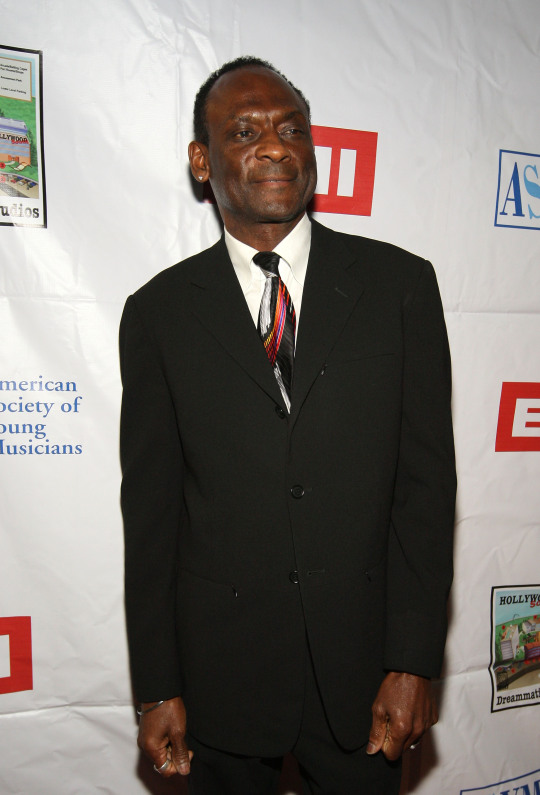
View On WordPress
#Celebrities#George ‘Funky’ Brown dead at 74: Kool & The Gang drummer and co-founder of iconic band dies after cancer battle#Money#Motors#Politics#ShowBiz#Sport#Tech#UK#US#World
0 notes
Text
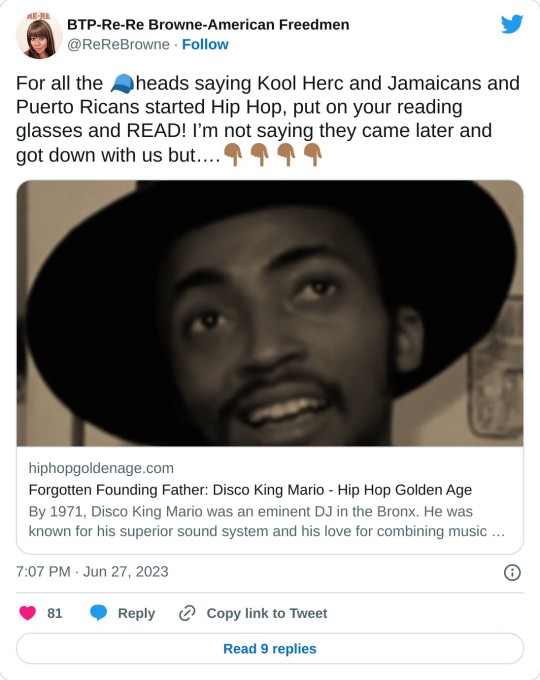

By 1971, Disco King Mario was an eminent DJ in the Bronx. He was known for his superior sound system and his love for combining music and a good time. Mario came up during the era where you had to be tough enough to bring your equipment out, because of how prevalent gangs and violence were in the Bronx in the early 70s. But the Disco King was respected all over, from neighborhood mothers to the grimiest gangsters. He is a major part of the creation of Hip Hop.
youtube
Disco King Mario was born in North Carolina in 1956 but moved to the Bronxdale Housing projects in order to escape working cotton and tobacco fields. He was an original member of the Black Spades, which is how his connection with Afrika Bambaata came about. Mario played whatever he wanted to play. He wasn’t playing breakbeats, but more uptempo disco. He was also a ladies man and was always fly, but still he was nobody to mess with.
The Disco King gained popularity by piecing together the best sounding system in the Bronx, and for the super live jams he would throw. DJ Kool Herc and Afrika Bambaata were both seen in attendance at these jams. Mario is credited for helping the culture spread because of his ability to manipulate people (in a good way) in order to allow them to use their venues for a party. He was able to lock down many venues and schools that other DJ’s couldn’t get.

With his connections, he would start to bring Afrika Bambaata along and allow Bam to assist him DJ. Disco King Mario is responsible for Afrika Bambaata’s early popularity by loaning him equipment and allowing him to play at all the different schools and parks he could get access to. He is also responsible for recognizing and grooming Busy Bee Starski, one of the best party rockers of that time.
“I went from Disco King Mario to Breakout,” said Busy Bee Starski in Yes Yes Y’all: The Experience Music Project Oral History Of Hip Hop’s First Decade. In that book, members of the Funky 4+1 also tell the story of how Disco King Mario saved Afrika Bambaata from losing a battle with them, by loaning Bam his amplifier:
youtube
Busy Bee: “It was Breakout and Bambaataa, and I was rappin’ with Breakout at that time. And Bambaataa needed some help with Breakout and Baron, I’m tellin’ you [laughing]! So Bambaataa had to call and ask Mario. He needed an amp. Mario said, “What happened?” He said, “I’m going to battle Breakout. He said, “Oh yeah? Then you need the Macintosh [amplifier]. You need this.”
DJ Baron: “Afrika Bambaataa was on one side of the gym, and we was on the other. The place was jam-packed. But Bambaataa had one up his sleeve: Disco King Mario had loaned Bam a power amp. We were going back and forth, and all of a sudden you couldn’t hear us no more [laughs], ‘cause Bam borrowed his amp from Mario and blew us out of the water, just drowns us out totally…”
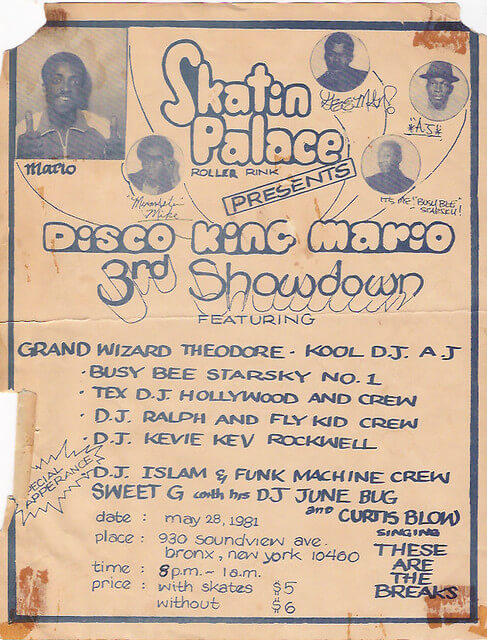
Disco King Mario died at the early age of 38, after a long battle with drugs during the ’80s. Many pioneers say that his early death is the reason for him being virtually written out of Hip Hop history. Others wish that more of the popular pioneers that are still around would acknowledge and pay homage to him more.
[Raises glass in the air]
So, here’s to Disco King Mario for helping lay the foundation for the Hip Hop culture. May he Rest in Peace.
#Forgotten Founding Father: Disco King Mario - Hip Hop Golden Age#disco#hip hop#Black Music#King Mqario#bronx#nyc#Youtube
20 notes
·
View notes
Text
The Metro #670
This week on The Metro, Warlock Jeff Ivins brings you the following bands for your time warp to the 1980s: The Belle Stars, Bucks Fizz, Shalamar, UB40 with Chrissie Hynde, Stray Cats, The Art Of Noise, The Blow Monkeys, Dexys Midnight Runners, Grandmaster Flash & The Furious Five, Kool & The Gang, Harold Faltermeyer, Madness, Frankie Goes To Hollywood, Japan, Level 42, Shakin’ Stevens, and…

View On WordPress
#Beastie Boys#Bucks Fizz#Dexys Midnight Runners#Frankie Goes to Hollywood#Grandmaster Flash & The Furious Five#Harold Faltermeyer#Japan#Kool & The Gang#Level 42#Madness#radio free satan#Shakin&039; Stevens#Shalamar#Stray Cats#The Art of Noise#The Belle Stars#The Blow Monkeys#the metro#UB40 with Chrissie Hynde#warlock jeff ivins
8 notes
·
View notes
Text
FEEDBACK LOOP #12: AJ Suede's "Most Black Superheroes"

Hands of onyx—my magnetic field fuck up electronics, I’m shielded—they feel it fusing. Born from nothing, sudden futures.
—ELUCID, “Ghoulie” (2022)
Boogying to my Walkman with the S on my chest.
—Redman, “A Day of Sooperman Lover” (1992)
Charlie Parker was a great electrician who went around wiring people.
—Bob Kaufman, “Fragment” (1959)
Although electricity, like the air around us, seems very impalpable, appealing to so few of the senses, it is yet capable of being measured…
—Lewis Latimer, from Incandescent Electric Lighting: A Practical Description of the Edison System (1890)
1.
Black superheroes harness power outside themselves—channeling it, conducting it—becoming maestros of electro-ultra-magnetics, masters of ceremony. Amiri Baraka assessed the drumming of Sonny Murray, speaking of “his body-ness, his physicality in the music,” concluding that Murray was “a conductor of energies.” AJ Suede has reinvented himself as one Ark Flashington, and he’s cold lampin’. On “South Bronx,” KRS-One describes how “power from a streetlight made the place dark.” A cold lamp is one drained of its energy—its electricity siphoned to illegal sources. Think of New York City going dark during the blackout of July 13, 1977. Think of how the subsequent looting led to audio equipment ending up in the hands of budding creators. Think of the scene in Stan Lathan’s Beat Street from 1984: how they run wires from the abandoned building in the Bronx to a lamppost. The building, burnt out five times by an arsonist landlord collecting on insurance money, is given new life. The electricity stolen from the lamppost powers Kenny’s turntables and gets the party jumping. Jeff Chang details how the Ghetto Brothers played on the block by “plugging their amps into the lampposts.” He quotes Kool Herc divulging how he did the same, sharing a hack he’d learned watching construction workers: “I had a big McIntosh amp…300 watts per channel. As the juice start coming, man, the lights start dimming.” Light and dark merge like the twisting of two frayed wires. Psycho Les promised to “pump more watts than any RadioShack” on the Beatnuts’ “World’s Famous,” and all these examples prove how potent tinkering can be: a life-giving force, a revived pulse.

2.
The precedent for suggesting superheroic poetics in hip-hop is congenital. Captain Sky’s “Super Sporm” traveled through the vas deferens (vas def?—mos def!) in 1978, smooth operations and muscle contractions assured its arrival in Big Bank Hank’s “Rapper’s Delight” lyrics in 1980 (“I can bust you out with my super sperm…”), and Kurtis Blow accepted the secretions in 1985 (the same year he told us, coincidentally, AJ is cool—no question). Seminal indeed!
Redman’s “A Day of Sooperman Lover” (1992) is Blowfly-level spoofing—not so heroic or chivalric as the song turns from rescuing a kitty cat to a Crying Game situation where our caped crusader unexpectedly “felt the bozack” of his beloved. Worth noting that when Reggie “dipped into [his] Sooperlover suit” it was accompanied by a “quick flash.” The rendezvous might’ve been chaotic but it was no Black Steel in the Hour of Chaos. Suede needs that steel to be ultra-conductive—something like Tricky’s “Black Steel” rendition. Something similar to “The Adventures of Grandmaster Flash on the Wheels of Steel” (1981). Flash’s early opus of the scratch and prismatic turntablism relied on disassembly of The Official Adventures of Flash Gordon (1966) record as much as it did disco data and funk fodder. Look up in the sky—yeah, above the clouds like Gang Starr in ’98, with Preemo pulling from Superman: The Man from Krypton, a 1978 children’s record.

The fixation probably apexed with the Last Emperor’s “Secret Wars.” “What if I had the power to gather all of my favorite MCs,” he proposed, “with the illest comic book characters and they became archenemies?” The original writing and recording of “Secret Wars” dates back to 1995 and ’96. Last Emp told David Ma that MCs and superheroes both operate as “modern day mythology.” Hip-hop heads decolonized comic conventions like Fanon, placing Black Masks over White Skins: Jean Grae, Ironman, MF DOOM, et cetera, and it don’t stop, and it can’t stop.
3.
The fact that most Black superheroes use electricity speaks to a historical tendency for [particularly non-Black] comic writers and illustrators to codify stereotyped representations of identity. AJ Suede, though, celebrates the commonality of so many Black superheroes with an emphasis on their weaponizing of electricity. Purveyors of potent defenses (a double portion of protection, ELUCID would say) whose Main Source of power derives from an [ec]static breaking of atoms.
Suede deads the myth of superpredator and elevates a superhero mythopoeia super-suited to an Age of Incendiary Devices. He assembles a team (in hip-hop we might call it a crew) of comic book characters to demonstrate that most Black superheroes use electricity. Whether he presents this as a tired trope or point of pride is left ambiguous, but I prefer to think of it as a salute to the commonality.

4.
AJ Suede holds a “couple of lanterns, lighting the path,” and the desire path leads us to Edison’s Lab in Menlo Park, New Jeruzalem. It was there that Lewis Latimer took eight steps to perfecting the carbon filament after Edison caught the L. Latimer literally wrote the book on electric light: Incandescent Electric Lighting: A Practical Description of the Edison System. History, as it goes, has made Latimer the lesser-known, but we can measure his impact in such luminaries as Bigg Jus. “I blow mics like filaments,” Jus rapped on CoFlow’s “Silence.” “I’m tungsten light within that causes something.” Something. What it causes must be too ineffable. Suede describes his “armor like tungsten, wolfram, / Wonder who indestructible.” Last Emp teased, Inconceivable? Unbelievable? On “Electric Relaxation,” Q-Tip claimed to be “stronger than Teflon.” We can thank Lewis Latimer for the threaded socket as well. See it on the cover of the Project Blowed compilation from 1995: a bare bulb hanging down, suspended in a white void, hinting at the empty-headed ingenuity of the most virtuosic freestyles to emerge from the MCs serving the Good Life. “There’s something special inside of my mental cargo vessel,” Aceyalone raps on “I Think,” “and it runs on lethal, ethyl methane, profane, / Kinda like a flux capacitor.” He thinks—bright bulb idea sharer. 88 MPH stream-of-consciousness thoughts. 1.21 gigawatts powered by either plutonium or hooked pole + lightning bolt.

5.
Granville T. Woods got labeled “Black Edison,” but—actual fact—Thomas Alva should’ve been dubbed “White Woods.” Edison tried to jack Woods’ steez, claiming ownership (as oppressors are wont to do) to his patents, but Woods was having none of that litigious noise and won in court. Edison wanted credit for a creation that wasn’t his, but Woods was like, “That goddamn credit? Dead it, / You think a white inventor paying you back?—shit, forget it!” With his Synchronous Multiplex Railway Telegraph, Woods equipped trains with magnetic forces for the purpose of communication long before DONDI and FUTURA were bombing ’em.
And what was Edison up to in the meantime? He produced an 1896 film, The Watermelon Eating Contest, which featured “two of the colored gentry eating melon on a wager.” In 1905, he promulgated a worser racial cinematic vision with the Edwin S. Porter-directed The Watermelon Patch, which depicts a melon heist by “darkies” and a pursuit of the thieves by scarecrows-turned-skeletons. Subsequently, we see bloodhounds and cakewalking. On “Most Black Superheroes,” AJ Suede circumvents the mob. He moves “left with the science, but right with the math.” Red-right, white-left, Buck 65 rapped in 1999, memorizing his RCA cables. The wrath of Suede’s math is on par with Jeru’s—he knows how and when to plug in, to plug tune, when to summon storms from the grass surrounding the watermelon patch.

6.
That AJ Suede is singing about Black superheroes distracts from his own heroics. Behind his “Ark Flashington” alter ego, Suede gathers the “harvest abundant [for] feeding the village.” The pun on “arc” weds his electrifying powers to “ark” in a Noachian sense. “Ark,” from the Latin arca, meaning “chest,” alludes to a coffer for storing secrets (abilities, identities) or a chest in an anatomical or figurative sense: the seat of emotional strength and fortitude. The “ark” in Ark Flashington, there-to-the-fore, is the chest from which AJ Suede’s arcane language springs. As purple lightning flashed and purple haze lifted, Cam’ron rapped on 2004’s “More Gangsta Music” about “walk[ing] around like [he’s] got an S on [his] chest.” He had the “Tec on [his] left,” but it’s not a TEC-9 in Suede’s case; it’s a high-voltage technology.
7.
As AJ Suede welds words together, there’s the constant risk of an arc flash—something, as his loyal listeners, we’d masochistically welcome. The way he tangles spools of l’s (“billionaire”; “still feel”) and coils conductive short-u’s (“deductibles”; “government”; “clusterfuckable”; “but”; “wonderful”) leaves us feeling vaporized. (We caught the toxic fume vapors!)

As such, we should come correct in PPE. Contact artist Lonnie Holley to commission a replica of his “African Mask” (2004)—a welder’s mask, actually, wreathed by a radial tire. Ribbons of rubber and sockets hanging like talismans and outlet boxes. This assemblage of scraps links [literally] the millennia-old metallurgy in Nigeria with the 20th century segregated workforce at Sloss Furnaces in Birmingham. Rockin’ the protective Holley headpiece will have you “feel[ing] wonderful,” as Suede says. You’ll be ready to drop a gem on ’em or, conversely, run the joules. You’ll look like the masked figure on the cover of Ark Flashington—all psychedelic oversaturation and electromagnetic energy exuding outward. Replace the S on your chest with the same inflammable material emblem from Massive Attack’s debut—embrace a “Safe from Harm” simmering beneath the surface of your epidermis.
8.
“Alternating current in the blood gets channeled,” AJ Suede raps as he morphs verb into noun. You’re sitting on your sofa alongside Canibus tuning into Channel Zero, but the cathode-ray tube is on the fritz. Screen all fulla snow. Suede juxtaposes the light and dark of alternating current electricity in our TV sets and—like David Lynch—reveals the light and dark media representations of humanity.

The current carries “through the fingertips and eyes, / Talking to the skies” like Lynch settles his camera on #6 utility poles. Over the course of his career, the Twin Peaks director has been partial to electricity. “I don’t know why all people aren’t fascinated with it,” he said in 2006. “It makes beautiful sounds, and it makes a lot of times some incredible light. It runs many things in our world, and it’s beautiful. It’s sometimes dangerous, but it’s magical. It’s such a power….” He speaks to the ethos of Ark Flashington, and Suede’s “Most Black Superheroes” delves headlong into the racial components. Sure, Lynch has the soot-blackened faces of the Woodsmen (“Gotta light?” one infamously asks). He hideously birthed the “jumping man” (leaping tall buildings in a single bound…) above the convenience store in Fire Walk With Me (1992). The “jumping man” is acted by Carlton Lee Russell, a Black man, though he wears a mask of white plaster. A second Black man, credited fittingly as “the electrician,” is also present in that surreal scene. But these racial undertones are just that—rarely discussed contexts secondary to Lynch’s infatuation with the direction of electron flow and the nature of good and evil. No more than minstrelsy of the manic and unhinged, if that. AJ Suede sacrifices everything on the gallows-like altar of a transmission tower in order to get us closer to overstanding.
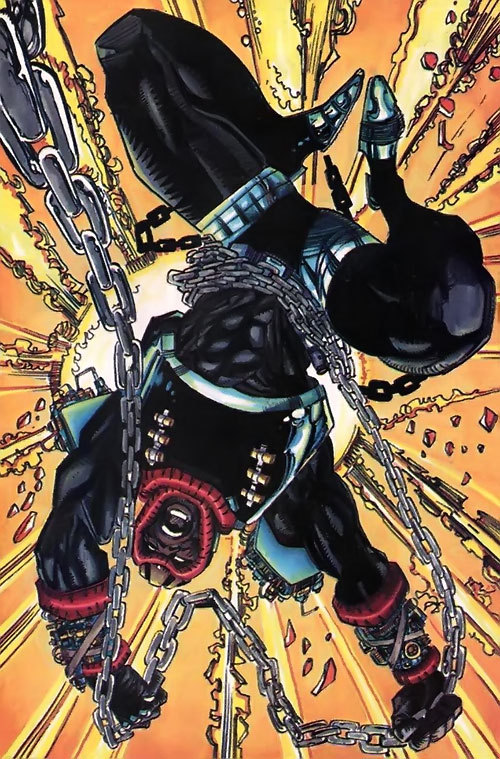
9.
Remember how they treated Black soldiers after Nam? By simply raising the question, AJ Suede raises hell and reminds us. “Never give help,” he says, subverting the saves-the-day super duty tough work of your typical superheroes, “’cause they don’t give a damn.” History is a weapon which can be used to recognize the difference between a worthy rescue and an informed recusal.
In Seize the Time (1970), Bobby Seale’s account of his days developing the Black Panther Party, a current navigates through his narrative—“current” in both senses: contemporaneous to his volatile times and the flow of charged particles. Writing at the height of the Black Power movement [calculate Black power in wattage], he notes that our “modern, highly technological society” includes pervasive “electronic surveillance,” in addition to and aiding the efforts of “cops armed and equipped for overkill.” Electricity found its path into his earlier employment struggles, too. “I worked at Kaiser Aerospace Electronics near Oakland,” he writes. “It involve[d] testing for microscopic cracks in metals by a complicated chemical and magnetic process.” Despite mastering the trade and finding the knowledge rewarding, he quit a little over a year later because he conscientiously objected to where the company was moving: “[T]he war was going on and I felt I was aiding the government’s operation.” Government clusterfuckable, in Suede’s words. Later, as Seale was transported by US Marshals across state lines, he spent a layover in a Salt Lake City lockup, what he refers to as “a completely electronic jail.” The future shock of his detainment, with its “doors [that] opened and closed electronically”—absent the necessity of any human touch—reminded him of a “streamlined concentration camp.” “I was on a political charge,” he writes [my emphasis]—quarks, protons, and electrons notwithstanding—and ultimately this seeming scientifikal fact limits his options. “If I escaped,” he reasoned, “everybody would believe I was guilty of all that jive, those trumped-up charges. At the same time I knew darn well the power structure is going to move and do everything they can to try to convict me and railroad me into prison and the electric chair.” And there’s no glory in damning yourself to the living/dying embodiment of Eric Haze’s iconic Death Row Records logo, is there?

10.
Black people must ultimately come to realize that such coalitions, such alliances have not been in their interest…[I]n fact, the whites enter the alliance in many cases precisely to impede that progress.
—Kwame Ture and Charles V. Hamilton, Black Power: The Politics of Liberation in America (1967)
Ture and Hamilton point to labor unions to emphasize “the treacherous nature of coalitions.” As unions achieved collective bargaining rights nationwide, Black workers experienced “deterioration.” In the 1940s, the International Brotherhood of Electrical Workers (Suede’s new crew name, if I had my way) got their victory, but Black laborers were contracted out of the union. Ture and Hamilton quote Myrna Bain: “The excuse was advanced that, since their union contract specified ‘whites only,’ they could not and would not change this to provide continued employment for the Negroes who were at the plant before the union was recognized.”
“Fuck what you got,” AJ Suede raps, liberals, well-wishers, and allies “can’t change spots.” In fact, it’s not a matter of “can’t”—they won’t change spots. The only math they know is a zero-sum game. “After handshakes people still change plans,” so like Public Enemy said, you can’t truss it.

11.
What recourse does AJ Suede have? He signals the skies and gathers the [Black] powers available to him. He recruits Dwayne McDuffie and Robert L. Washington III’s Static, giving props to Virgil Hawkins’ namesake static bolts that sizzle and criss-cross into a Malik El-Shabazz “X” on the front panel of his cap. He hangs a banner from the 1994 inaugural issue: YOU DON’T START NONE THERE WON’T BE NONE. Time is illmatic, of course, and Nas tells us he “keep[s] static like wool fabric”—linking electricity, beef, and even “the kinkiness of Black people’s hair.”
Suede calls upon Black Lightning, tapping his ability to ionize illbient beats and throw up a force field before fists. He brings in Black Vulcan from the Super Friends in case they need to spot-weld the Fugees' "Ready or Not" submarine (on loan). He looks to da baddest bitch—no, not Trina (though she fellates at a pace “like lightning”)—but to Storm, relying on her to psionically and atmokinetically keep the peace. Hardware heads over with metal alloys looted from Alva Industries. In the same way Milestone Comics diverged from the prevailing archetypes and tokenism of Black superheroes, AJ Suede builds a posse that can apply pressure through a low-pass filter or phaser.
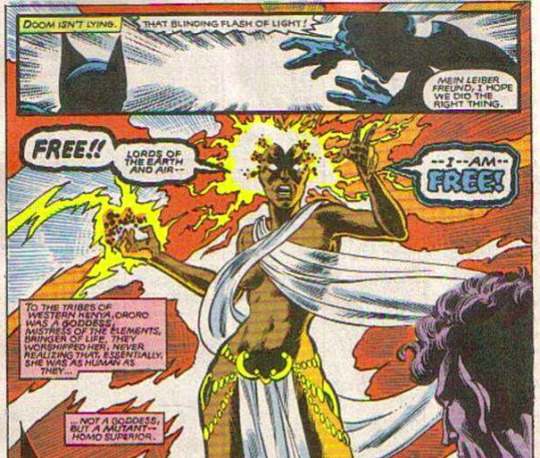
“Most Black Superheroes” survives on the subtle cracking and clicking of the Geiger counter in a tick-tock Doomsday clock loop rendered rhythmic: a molecular metronome. Drums tapped out on a cellar circuit breaker rather than an SP-404. Yes, most Black superheroes use electricity, and AJ Suede turns his sine waves square through a fuzz pedal. He abuses the tube amp until he achieves Electro Harmonix. He regulates the barometric pressure between Seattle and Bristol, rhyming at a rainy-day downtempo BPM, tautens the tripwire, and sends the circuit breaker tripping. His woofers thud the trunk of the jeep with melanated melankolic bass tones. “Most Black Superheroes” is an electric boogaloo of AJ Suede’s own mad scientist invention—a hip-hop park jam of resistance and Vedic possibilities where ohm meets om.

Images:
David Lynch, The Factory Photographs, 2014 (detail) | Captain Sky, The Adventures of Captain Sky, album cover (1978) | Superman: The Man From Krypton, Peter Pan Records (1978) | Lewis Latimer, “Electric lamp” (with Nichols, Joseph V.), patent (1881) | Project Blowed compilation, album cover (1995) | The Watermelon Patch, screenshot, Edison Films (1905) | Lonnie Holley, African Mask (2004) | David Lynch, “Electricity in Hand and Home” | Hardware, appearing in Milestone Comics (issue unknown) | Black Lightning in Justice League of America #174, (Jan. 1980) | Static, Issue 1, Dwayne McDuffie and Robert L. Washington III, DC Comics (May 4, 1993) | Storm, appearing in Marvel Comics (issue unknown) | David Lynch, The Factory Photographs, 2014 (detail)
8 notes
·
View notes
Text
Central Regional - Group P
The March Madness of American Rock Bands tournament begins with our geographically largest regional. Vote for your favorite band! The top two vote recipients move on to the next round.
Reminder: There are so many bands from California, New Jersey and New York that you will find some of them "on tour" in other regions.
Paul Revere and the Raiders (Boise ID)
Junior Walker & the All-Stars (Battle Creek MI)
Kool and the Gang (Jersey City NJ)
Garbage (Madison WI)
4 notes
·
View notes
Text
Kool & The Gang - Joanna [80's R&B] (1983)
Kool & The Gang - Joanna [80's R&B] (1983)
https://youtu.be/hsklsxReSe0?si=MH8Nx3LX8GELjsHH
Submitted June 29, 2024 at 09:33AM by Blowaway040889 https://ift.tt/N2JUjT8
via /r/Music
0 notes
Text
Saturday, April 29, 2023 2pm ET: Number One Album of 1978: Saturday Night Fever Soundtrack (1977)
Saturday Night Fever is the soundtrack album from the 1977 film Saturday Night Fever starring John Travolta. The soundtrack was released on November 15, 1977. It is one of the best-selling albums in history, and remains the second-biggest-selling soundtrack of all time, after The Bodyguard, selling 40 million copies worldwide (double-disc album).
In the United States, the album was certified 16×…

View On WordPress
#Bee Gees#David Shire#Feature LP#KC & The Sunshine Band#Kool & The Gang#MFSB#RadioMax#Saturday Night Fever#Tavares#Trammps#Walter Murphy#Wikipedia#Yvonne Elliman
0 notes
Text
MUSIC MONDAY: "Summer Breeze" - a Summer Songs Playlist for 2022 (LISTEN)
MUSIC MONDAY: “Summer Breeze” – a Summer Songs Playlist for 2022 (LISTEN)
by Jeff Meier (FB: Jeff.Meier.90)
Today on #MusicMonday, we’re celebrating the beginning of Summer 2022, which officially kicks off tomorrow.
One of our most popular playlists of the last couple years was our Summer Breeze: Soulful Summer Songs playlist, which we created two years ago in the midst of the pandemic.
So this year, we’ve taken that original playlist and created the ‘new and improved’…

View On WordPress
#"Porgy & Bess"#musicmonday#Anderson.Paak#Anita Baker#Carl Thomas#Chic#Childish Gambino#DJ Jazzy Jeff & Fresh Prince#James Brown#Jeff Meier#Jhené Aiko#Jim Jones#Joan Armatrading#Johnny Mathis#Kool & the Gang#Labi Siffre#Leon Bridges#Megan Thee Stallion#Nat King Cole#Prince#Sly & The Family Stone#St. Lunatics#summer music#summer songs#The Isley Brothers#war
11 notes
·
View notes